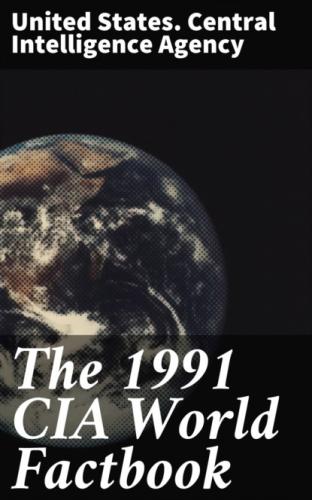Crown Hill, 16 Middle Road, Devonshire, Hamilton (mailing address is
P. O. Box HM325, Hamilton HMBX, or FPO New York 09560–5300); telephone
(809) 295–1342
_#_Flag: red with the flag of the UK in the upper hoist-side quadrant and the Bermudian coat of arms (white and blue shield with a red lion holding a scrolled shield showing the sinking of the ship Sea Venture off Bermuda in 1609) centered on the outer half of the flag
_*Economy #_Overview: Bermuda enjoys one of the highest per capita incomes in the world, having successfully exploited its location by providing luxury tourist facilities and financial services. The tourist industry attracts more than 90% of its business from North America. The industrial sector is small, and agriculture is severely limited by a lack of suitable land. About 80% of food needs are imported.
_#_GDP: $1.3 billion, per capita $22,400; real growth rate 2.0% (1989 est.)
_#_Inflation rate (consumer prices): 5.8% (June 1989)
_#_Unemployment: 2.0% (1988)
_#_Budget: revenues $307 million; expenditures $275 million, including capital expenditures of $31 million (FY90 est.)
_#_Exports: $30 million (f.o.b., FY88);
commodities—semitropical produce, light manufactures;
partners—US 25%, Italy 25%, UK 14%, Canada 5%, other 31%
_#_Imports: $420 million (c.i.f., FY88);
commodities—fuel, foodstuffs, machinery;
partners—US 58%, Netherlands Antilles 9%, UK 8%, Canada 6%, Japan 5%, other 14%
_#_External debt: NA
_#_Industrial production: growth rate NA%
_#_Electricity: 154,000 kW capacity; 504 million kWh produced, 8,640 kWh per capita (1990)
_#_Industries: tourism, finance, structural concrete products, paints, pharmaceuticals, ship repairing
_#_Agriculture: accounts for less than 1% of GDP; most basic foods must be imported; produces bananas, vegetables, citrus fruits, flowers, dairy products
_#_Economic aid: US commitments, including Ex-Im (FY70–81), $34 million; Western (non-US) countries, ODA and OOF bilateral commitments (1970–88), $267 million
_#_Currency: Bermudian dollar (plural—dollars); 1 Bermudian dollar (Bd$) = 100 cents
_#_Exchange rates: Bermudian dollar (Bd$) per US$1—1.0000 (fixed rate)
_#_Fiscal year: 1 April-31 March
_*Communications #_Highways: 210 km public roads, all paved (about 400 km of private roads)
_#_Ports: Freeport, Hamilton, Saint George
_#_Merchant marine: 84 ships (1,000 GRT or over) totaling 3,826,756 GRT/6,932,981 DWT; includes 3 short-sea passenger, 8 cargo, 7 refrigerated cargo, 4 container, 8 roll-on/roll-off, 26 petroleum, oils, and lubricants (POL) tanker, 11 liquefied gas, 17 bulk; note—a flag of convenience registry
_#_Civil air: 16 major transport aircraft
_#_Airports: 1 with permanent-surface runways 2,440–3,659 m
_#_Telecommunications: modern with fully automatic telephone system; 52,670 telephones; stations—5 AM, 3 FM, 2 TV; 3 submarine cables; 2 Atlantic Ocean INTELSAT earth stations
_*Defense Forces #_Branches: Bermuda Regiment, Bermuda Police Force, Reserve Constabulary
_#Note: defense is the responsibility of the UK % @Bhutan *Geography #_Total area: 47,000 km2; land area: 47,000 km2
_#_Comparative area: slightly more than half the size of Indiana
_#_Land boundaries: 1,075 km total; China 470 km, India 605 km
_#_Coastline: none—landlocked
_#_Maritime claims: none—landlocked
_#_Climate: varies; tropical in southern plains; cool winters and hot summers in central valleys; severe winters and cool summers in Himalayas
_#_Terrain: mostly mountainous with some fertile valleys and savanna
_#_Natural resources: timber, hydropower, gypsum, calcium carbide, tourism potential
_#_Land use: arable land 2%; permanent crops NEGL%; meadows and pastures 5%; forest and woodland 70%; other 23%
_#_Environment: violent storms coming down from the Himalayas were the source of the country name which translates as Land of the Thunder Dragon
_#_Note: landlocked; strategic location between China and India; controls several key Himalayan mountain passes
_*People #_Population: 1,598,216 (July 1991), growth rate 2.0% (1991)
_#_Birth rate: 37 births/1,000 population (1991)
_#_Death rate: 17 deaths/1,000 population (1991)
_#_Net migration rate: 0 migrants/1,000 population (1991)
_#_Infant mortality rate: 135 deaths/1,000 live births (1991)
_#_Life expectancy at birth: 50 years male, 48 years female (1991)
_#_Total fertility rate: 4.9 children born/woman (1991)
_#_Nationality: noun—Bhutanese (sing., pl.); adjective—Bhutanese
_#_Ethnic divisions: Bhote 60%, ethnic Nepalese 25%, indigenous or migrant tribes 15%
_#_Religion: Lamaistic Buddhism 75%, Indian- and Nepalese-influenced Hinduism 25%
_#_Language: Bhotes speak various Tibetan dialects—most widely spoken dialect is Dzongkha (official); Nepalese speak various Nepalese dialects
_#_Literacy: NA% (male NA%, female NA%)
_#_Labor force: NA; agriculture 93%, services 5%, industry and commerce 2%; massive lack of skilled labor
_#_Organized labor: not permitted
_*Government #_Long-form name: Kingdom of Bhutan
_#_Type: monarchy; special treaty relationship with India
_#_Capital: Thimphu
_#_Administrative divisions: 18 districts (dzongkhag, singular and plural); Bumthang, Chhukha, Chirang, Daga, Geylegphug, Ha, Lhuntshi, Mongar, Paro, Pemagatsel, Punakha, Samchi, Samdrup Jongkhar, Shemgang, Tashigang, Thimphu, Tongsa, Wangdi Phodrang
_#_Independence: 8 August 1949 (from India)
_#_Constitution: no written constitution or bill of rights
_#_Legal system: based on Indian law and English common law; has not accepted compulsory ICJ jurisdiction
_#_National holiday: National Day (Ugyen Wangchuck became first hereditary king), 17 December (1907)
_#_Executive branch: monarch, chairman of the Royal Advisory Council, Royal Advisory Council (Lodoi Tsokde), chairman of the Council of Ministers, Council of Ministers (Lhengye Shungtsog)
_#_Legislative branch: unicameral National Assembly (Tshogdu)
_#_Judicial branch: High Court
_#_Leaders:
Chief of State and Head of Government—King Jigme Singye WANGCHUCK (since 24 July 1972)
_#_Political parties: no legal parties
_#_Suffrage: each family has one vote in village-level elections
_#_Elections: no national elections
_#_Communists: no overt Communist presence
_#_Other political or pressure groups: Buddhist clergy, Indian merchant community; ethnic Nepalese organizations leading militant antigovernment campaign
_#_Member
